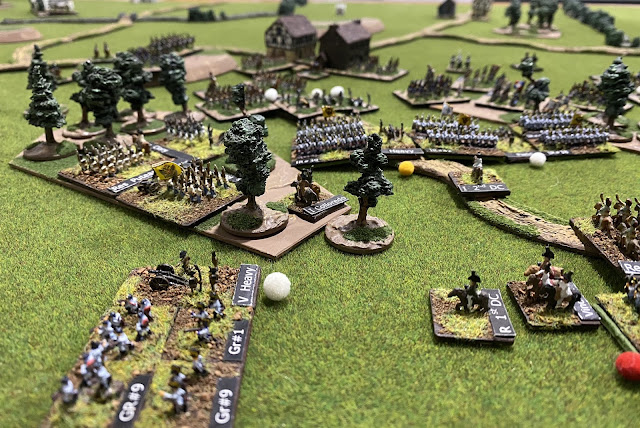Marshal Ney surveyed the scene before him. In the distance the Austrian infantry were formed along a hill some 900 yards in length. To their right they garrisoned the town of Elendorf, while to the left the Austrian line extended to another town and beyond to a wood. Certainly the Austrian position offered a solid defensive. Yet, Ney was confident his forces were well placed. His converging corps were concentrated and well placed to unhinge the Austrians and inflict a crushing defeat.
The French centre and left comprised Marmont’s VI Corps, some five divisions. A mix of veterans and provisional brigades though all with solid morale. The French right was centred around Lauriston’s weak V Corps, just two infantry divisions but the corps was supplemented by Pajol’s V Cavalry Corps. This last comprising no less than three cavalry divisions under Pire, l’Heritier and Milhaud. Further, they were poised to fall on the open flank of the Austrian left having conducted a flanking manoeuvre.
The battle opened in the centre where Ney ordered a general advance by his infantry. While the enemy deployed on the high ground were pinned, the brigades of Lagrange’s Division were ordered to capture Elendorf. The division, comprised of provisional troops, may have lacked the ability to complete complex manoeuvre their motivation was unquestioned. Advancing boldly the town was soon in French hands the Austrian garrison being unceremoniously ejected.
Below, the attack on Elendorf with Ney encouraging his troops at great personal risk.
Below the situation around Elendorf viewed from the French left.
On the French right Pajol’s cavalry were now on the field and moving with speed against the Austrian formations deployed on the Austrian left. An Austrian Light Division was particularly isolated and rather than face the French cavalry fell back into a large wood. Yet even here they were not safe. Engaged by the infantry of Albert’s Division the disorganised Austrians were pushed out of the woods only to be cutdown by the Hussars and Chasseurs of Pire’s Division.
The twin attacks on the Austrian centre and left forced Schwarzenburg to order the retirement of his other divisions. The well drilled Austrians now fell back to an alternate defensive line. Ney continued to press the enemy, again the Austrians fell back.
Here the centre where the Austrian form an initial defence having abandoned the ridge.
With little room for further retreat the Austrian centre formed for a final defence. It rested on two woods which provided something of a bastion against the French advance, though not the grand battery of 36 French guns that soon formed opposite to pummel the white coated warriors.
Below, the final defensive line viewed from behind the Austrian position. Those in the left foreground block the advance of the French cavalry.
This new Austrian line was bolstered, in part, by the arrival of the much needed reinforcements. On the French right the dense terrain prevented further use of the French cavalry and as such caused a natural pause in the attack that only hours earlier promised so much. Yet on the French left Austrian reinforcements now poured on to the field. Ney was loosing the initiative.
Below, the Austrian reinforcements arrive on the Austrian right opposite the French left.
The dense ranks of Austrian infantry now moved forward against the outnumbered 22nd Division under Friederich on the French left.
Below, the Austrian right now further reinforced.
In support of Friederich Lorge’s 5th Light Cavalry Division delayed the advancing white coated ranks who cut a striking scene advancing under a their black double headed eagles well supported by light infantry.
Concerned by the overwhelming number of Austrian infantry Marmont ordered Compan’s veterans to reinforce the French left providing valuable time for Friederich’s brigades to fallback. Of course this commitment of troops, previously poised for a final push in the centre, meant that Ney’s last hope for a breakthrough had passed. Schwarzenburg’s Austrians had held.
The scenario was developed using the Road to Glory Scenario System. The Austrians using Card 9 “Echelon Left” while the French used Card 23 “Turning Manoeuvre Right”. The armies each comprised 3000 points. The French are from my collection and comprise Heroics & Ros miniatures. The Austrians are from Andrew’s collection with the infantry from Irregular Miniatures range and cavalry and artillery from Heroics & Ros.






Comments
Post a Comment